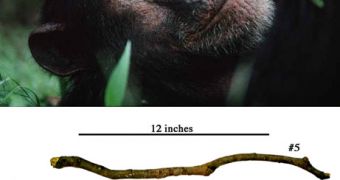You cannot live without French fries and chips, can you? Well, it seems this has something to do with our remote ancestry.
Anthropologist Adriana Hernandez-Aguilar of the University of Southern California has found for the first time proofs that chimps dig by using tools in order to eat tubers, roots, and bulbs, a finding confirming the theories about how early human ancestors passed from life in fruit-rich forests to drier savannas about 5 million years ago.
This behavior was detected in the Ugalla Forest Reserve of western Tanzania, a dry woodland savanna harboring a small chimpanzee population in a habitat very different from the wet forests.
Hernandez found knuckle prints, feces, dirt-smeared sticks and spit tuber fibers in 11 dig sites, 10 close to the chimp nesting places. The sticks were worn and bore a hard soil crust on one top, a sign they had been used for digging.
Unlike what was previously believed, the diggings were executed during the rainy season which was rich in food, thus tubers were not a last resort for food. Chimps are known to chew tubers and to spit out tough fibers. Some of the plants dug by chimps are also used by locals as food or medicine.
"The discoveries that they sometimes use tools [to access the underground foods], do so in the wet, resource-rich season, and that some of the plants may have medicinal properties-those were real surprises," Jim Moore of the University of California, San Diego, co-author of the study published in Proceedings of the National Academy of Sciences told National Geographic.
"30 years ago, we hypothesized that these belowground plant parts would have offered a rich food resource for early humans who were living in dry seasonal habitats such as bushland and savanna. Before that, [yam expert] D. G. Coursey suggested that even the crudest form of a digging tool would have put early humans at a marked evolutionary advantage for exploiting these foods," said John Kappelman, a professor of anthropology at the University of Texas.
"Well, this new work proves Coursey right, because the tools used by these chimpanzees are as simple as simple can be. And because they consist of thin pieces of wood, [they] are unlikely to be the sort of thing that would be preserved in the fossil record." he added.
Humans have been believed to be the only apes to search for tubers using tools, like we once believed that we were the only tool-using ape.
"It suggests to me that we will continue to redefine humans as we find more out about other species, especially our closest living relatives. I wouldn't be surprised to hear about more of these kinds of 'discoveries'-ones that cause us to rethink our definition of what a human is." said Jill Pruetz, an Iowa State University primate researcher, who discovered recently a Senegalese chimp population making "spears" for hunting small mammals.
The authors warn that the unique Ugalla chimp population faces a bleak future.
"Ugalla is adjacent to several camps housing people from Congo, Rwanda, and Burundi. These refugees may be responsible for heavy poaching reported in the last five years," said Moore, who has been studying these researches for 18 years.
Moreover, a proposed new major road could cross the area and "such roads almost always increase pressure on wildlife. If the refugees are repatriated to their home countries soon and development along the road is regulated, the area is in decent shape and wildlife will recover. If those things don't happen, the outlook isn't good." he explained.

 14 DAY TRIAL //
14 DAY TRIAL //